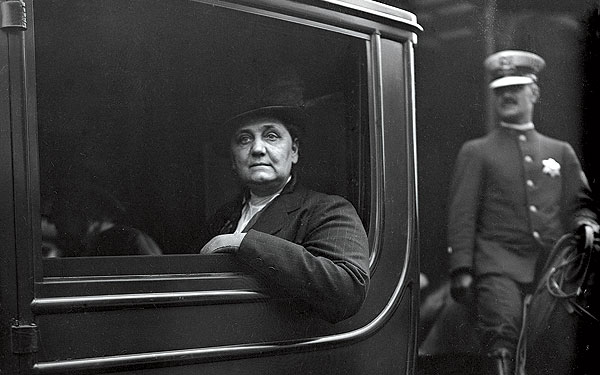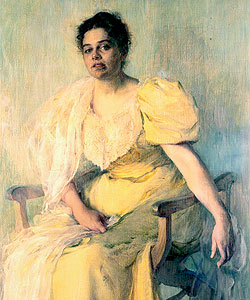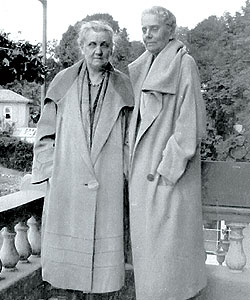
Jane Addams in 1915
|
|
When Jane Addams's travels took her away from her close companion Mary Rozet Smith, she sometimes took along a painting of Smith, even though the portrait was a rather bulky piece of luggage. Addams, the Nobel Peace Prize–winning social activist who founded Chicago's Hull-House in 1889, clearly felt a strong emotional attachment to the aristocratic, gracious woman in that picture, which now hangs at the Jane Addams Hull-House Museum—with a question mark for a caption.
For the past year, the museum has been seeking suggestions on how to label the portrait, which Addams commissioned from Alice Kellogg Tyler. Should the caption suggest Addams and Smith were companions? Lesbian lovers? Or simply focus on Smith's role as one of Hull-House's most generous financial supporters? This summer, as the museum gets ready to decide, a new WTTW documentary is stepping into the fray and staking out the position that Addams and Smith were lesbians. The producers of Out & Proud in Chicago, Alexandra Silets and Dan Andries, say their film on the history of gays and lesbians in the city wouldn't be complete without Addams. "In not revealing this part of Jane Addams's life, you're denying the rest of us a role model," says Silets, a lesbian.
Not everyone has such an easy time defining Addams and Smith, however. In a handwritten note at the Hull-House Museum, one visitor asked, "What does their sexuality have to do with their work?" On the museum's blog, someone claiming to be a relative of Addams remarked: "You should be keeping to the facts and not acting as potential gossip mongers." But some of Smith's relatives have told the museum's director, Lisa Yun Lee, that they proudly believe Smith was a lesbian. "We're a history museum, and it should be part of the historical record," Lee says.
That record includes letters between Addams and Smith that are filled with expressions of love and intense longing, but few hints at anything sexual. When the two women traveled together, Addams wired ahead to hotels, requesting a double bed. And when Smith was away in Europe in 1902, Addams wrote her a letter: "You must know, dear, how I long for you all the time. . . . There is reason in the habit of married folks keeping together." Based on such evidence, most of the authors who have written about Addams since 1970 conclude that Addams and Smith, neither of whom apparently had a romantic relationship with a man, thought of their 40-year friendship as a marriage of sorts.
|
|
In the late 1800s and early 1900s, some women formed close bonds and lived together, but their relationships weren't seen as sexual, says Gioia Dili-berto, the Chicago-based author of A Useful Woman: The Early Life of Jane Addams. "Romantic friendship was considered something very admirable and sweet," she says. "There was this idea that unless a man was involved, it wasn't really sex."
Addams and Smith may have shared a bed, but that doesn't necessarily mean they had sex. "Victorians would laugh at us because we're so uptight about sleeping in the same bed with other people," says Louise W. Knight of Evanston, author of Citizen: Jane Addams and the Struggle for Democracy. The question of what Addams and Smith did in bed should not be the main issue, says Lillian Faderman, author of several books on lesbian history. "These two women obviously loved each other and had a deep emotional bond," she says. "That's a good enough definition of lesbian to me."
Gays and lesbians giving one another strength is a key theme of Out & Proud, which airs in June on Channel 11 (Agate Publishing releases a companion book in September). The film's co-producer, Andries (who is straight), says he cried at his desk one night as he read the transcript of an emotional interview. "It's a struggle for human rights," he says.
According to Silets, the film gives a marginalized community something it has been clamoring for: a history. As far as she and Andries are concerned, that history rightly includes Jane Addams alongside other gays and lesbians—such as ragtime pianist Tony Jackson and literary editors Margaret Anderson and Jane Heap—people who made a mark on Chicago long before gay pride was a concept.
Photography: (Image 1) Chicago History Museum; (Image 2) Courtesy of Jane Addams Hull-House Museum; (Image 3) The Swarthmore College Peace Collection





